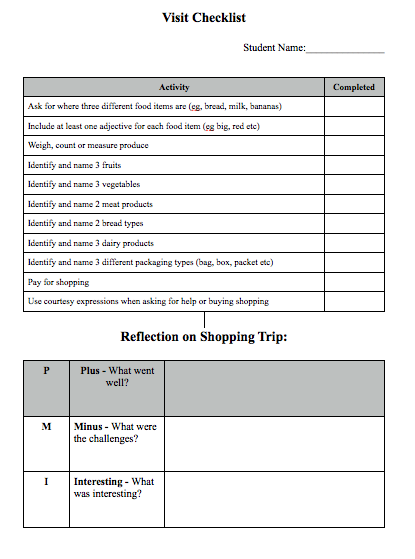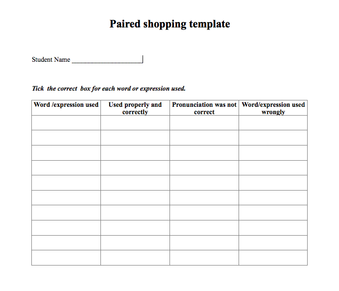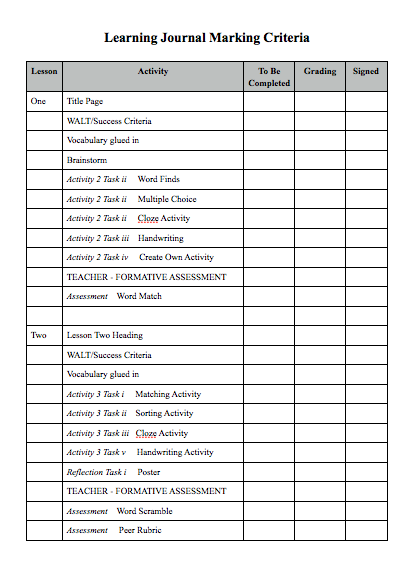Lesson Six
|
Learning Intention: For students to experience and transfer the vocabulary, sentence structures and the grammar they have learnt throughout the unit in real or authentic environments outside the classroom. Students will demonstrate developing knowledge of vocabulary and sentence structures through a reflective journal. |
WALT (We Are Learning To):
1. Use the vocabulary and sentence structures we have learnt so far, in a shopping task.
2. Demonstrate our ability to use shopping vocabulary from this unit in English across a range of tasks and situations.
3. Monitor our own progress in this unit by recording reflections and evaluations in an on-going journal.
Success Criteria
We know we will have achieved this when:
1. We have successfully completed the shopping task using a broad range of vocabulary and sentence structures from across this unit.
2. We have successfully completed all tasks, activities and assessments set by the teacher.
3. We have recorded reflective journal entries and scores in our journal as indicated during each lesson.
Contents
Activity
Complete one of the following tasks that is relevant and appropriate to your situation. Teachers need to ensure that these tasks use a broad range of vocabulary and sentence structures from across this unit.
Share the learning intention with the students and discuss the purpose of the task. Revise some of the vocabulary and sentence structures which learners were finding difficult.
Task i
Visit to one of the following: Supermarket, Farmer’s Market, Grocery Store or Dairy.
Task ii
Plan a school market - this could be aligned with a school gala or festival. Parent support would be required to complete this activity.
Task iii
Run a food stall that uses food items from the vocabulary list within this unit (similar to running a sausage sizzle).
Task iv
Create a classroom store with stuffed used cartons, packets etc. You can set up different departments and children go round shopping without money or using fake money.
Brief Review
Discuss what students will see and do in the task. Discuss some possible scenarios which they might go through e.g. a conversation that might happen when you cannot find something on the shelves, a conversation that may happen at the deli, a conversation that might happen when get to the checkout.
Students can prepare little cards of memory joggers of the vocabulary and sentence structures they are not sure of.
Process
Task i
Use the following checklist to outline what students need to complete during their shopping visit:
http://www.familylobby.com/common/tt6115628fltt.gif Children add completed copy to Learning Journal.
Task ii
In small groups, students plan a stall using food items that come from the vocabulary lists from Lessons One to Five. Pre-organisation and set up needs to involve pricing products and display cards to market produce. Students can create posters to advertise the market around school or letters/invitations to school community. Students need to be shown how to run their stall and vocabulary including sentence structures should be reviewed and practiced.
Task iii
Parents are asked beforehand if they could provide food stuffs to be used on the stalls. These could include home baking, garden or farm produce of any other foodstuffs. (Food safety needs to be adhered to). In the classroom children in small groups design flyers or brochures to advertise the food stalls within the school community. They also prepare labels and price tags for the food stuffs. During this process they revisit the vocabulary and expressions learnt in lessons 1-5.
With the help of parents children set up stalls at a designated area within the school. They could set up a stall with home baking as the bakery, a produce section with garden and farm produce (even ones bought from the market) and a general grocery section for all the other foodstuffs.
During the shopping time learners take turns to run their stall while others go shopping in pairs. They visit different stalls and use at least 10 target words and 5 expressions. They write each others words and expressions and tick the correct box on how they were used on a provided template. This template should be pasted into their learning journals for reflection purposes.
Task iv
Learners are put in small groups and asked to prepare a department e.g. grocery section, butchery, bakery or produce section for a classroom store. They decide what they want to include in their department. Learners bring empty food cartons /packets etc from home which they have already stuffed with paper to give them a body. They use these to create a classroom store. If they do not have some items, they can use pictures or make some using papier mache (time permitting) and paint them.
They should also make name labels, price tags and set up their departments.
During the shopping time learners take turns to run their stall while others go shopping in pairs. They visit different stalls and use as much at least 10 target words and 5 expressions. They write each other’s words and expressions and tick the correct box on how they were used on a provided template. This template should be pasted into their learning journal for reflection purposes.
Reflection
As a class students discuss what they enjoyed and what challenged them. They discuss possible solutions for challenges. As individual learners write a short recount of their experiences during the visit/activity.
Assessment
Learning Journal
The learning journal will be completed by all students across all lessons and handed in to the teacher as a final assessment. The Learning Journal will be marked against the criteria set in the below rubric:
Formative
http://www.familylobby.com/common/tt6115628fltt.gif Ongoing teacher formative assessment of students. Teacher questions and reviews student progress providing formative feedback for individuals. Formative activities should be conducted across a range of whole class, group and individual activities regularly throughout the lesson. Feedback may be written or oral and may or may not be recorded for future reference as deemed appropriate by the teacher.
Written
http://www.familylobby.com/common/tt6115628fltt.gif Do a final vocabulary test of all the words in the unit. The teacher will describe twelve words in English and the students write down the vocabulary in a list. The students write down the mark in their learning journal and finish the graph. After this the teacher can get the students to come to the teacher one by one and reflect on their results.


